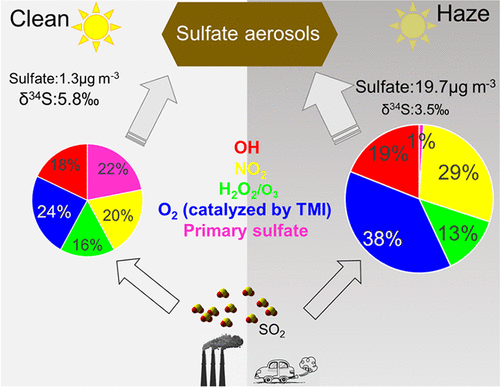当前位置:
X-MOL 学术
›
Environ. Sci. Technol. Lett.
›
论文详情
Our official English website, www.x-mol.net, welcomes your
feedback! (Note: you will need to create a separate account there.)
Roles of Sulfur Oxidation Pathways in the Variability in Stable Sulfur Isotopic Composition of Sulfate Aerosols at an Urban Site in Beijing, China
Environmental Science & Technology Letters ( IF 8.9 ) Pub Date : 2020-10-19 , DOI: 10.1021/acs.estlett.0c00623 Mei-Yi Fan 1, 2, 3 , Yan-Lin Zhang 1, 2, 3 , Yu-Chi Lin 1, 2, 3 , Jianghanyang Li 4 , Hongguang Cheng 5 , Ning An 5 , Yele Sun 6, 7, 8 , Yanmei Qiu 6, 7 , Fang Cao 1, 2, 3 , Pingqing Fu 9
Environmental Science & Technology Letters ( IF 8.9 ) Pub Date : 2020-10-19 , DOI: 10.1021/acs.estlett.0c00623 Mei-Yi Fan 1, 2, 3 , Yan-Lin Zhang 1, 2, 3 , Yu-Chi Lin 1, 2, 3 , Jianghanyang Li 4 , Hongguang Cheng 5 , Ning An 5 , Yele Sun 6, 7, 8 , Yanmei Qiu 6, 7 , Fang Cao 1, 2, 3 , Pingqing Fu 9
Affiliation

|
Sulfate (SO42–) is an important chemical species in atmospheric aerosols, which strongly impacts atmospheric chemistry processes and climate change. Stable sulfur isotopes (δ34S) of sulfate aerosols in PM2.5 were measured in Beijing from November 13 to December 2, 2018, to investigate the pathways of formation of sulfate aerosols. The results showed that SO42– constituted a major fraction (18%) of water-soluble ions and significant enhancement of sulfate was observed during the haze period. The δ34S-SO42– values averaged at 4.4 ± 1.4‰ during the full period, exhibiting a downward trend with an increase in sulfate concentration. The change in sulfur isotope values could not be explained by the changes in emission sources. Significant correlations were found between observed δ34S-SO42– values and SO2 oxidation ratios (R = −0.88; p < 0.01), indicating the changes in sulfur isotopes were attributed to the SO2 oxidation processes. On the basis of Rayleigh distillation, the average fractionation factor between SO2 and SO42– was 4.0 ± 1.2‰. Combining sulfur isotopes and the Bayesian model, we quantified the contributions of primary sulfate, OH, H2O2/O3, NO2, and O2 [catalyzed by transition metal ions (TMIs)] oxidation pathways to sulfate formation were 7%, 20%, 16%, 27%, and 30%, respectively. The contributions of TMI and NO2 pathways increased from 24% and 20% during the clean period to 38% and 29% during the haze period, respectively. Our results highlighted that sulfur dioxide oxidized by TMI-catalyzed O2 and NO2 were the dominant pathways of sulfate formation in Beijing under haze pollution during the heating seasons.
更新日期:2020-12-08











































 京公网安备 11010802027423号
京公网安备 11010802027423号